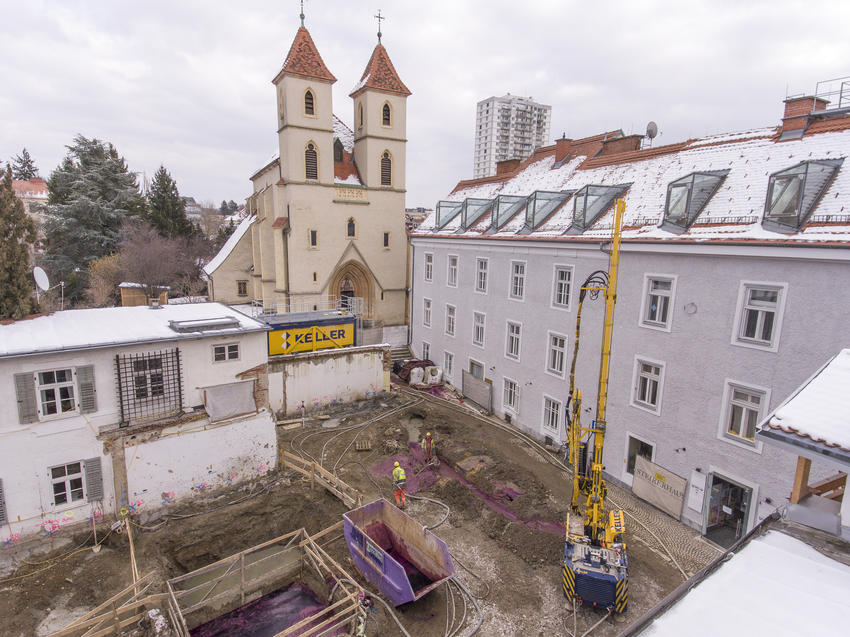When Keller was asked to provide a geotechnical solution for the construction pit of a new residential block on a contaminated site in Austria, it proposed an innovative technique that combined jet grouting, or Soilcrete, with an oxidising agent to simultaneously provide support and remediate the soil.

For several decades Rittegasse in Graz was home to the ST25 Putzerei Plachy – a former clothes dyeing and later dry-cleaning and laundrette business. Apparently, over many years, the cleaning agent tetrachloroethylene seeped into the ground, leading to heavy subsoil contamination.
When the property was demolished with the plan to build residential premises, Keller was brought in to provide support for the construction pit.
“Originally the plan was to use bored piling and then dispose of and treat the excavated material off-site,” explains Peter Freitag, Keller Grundbau’s lead on environmental techniques. “However, it quickly became clear the site was too small for a bored piling rig. Also some contaminated areas were under the street and nearby buildings where no excavation was possible, and other treatment difficult.”
Introducing HaloCrete®
To solve the problem, Keller proposed HaloCrete® – an innovative process that involves adding a chemical reactant to the jet grouting slurry mix, strengthening the ground with concrete columns while, at the same time, degrading the contaminant in situ.
In this case, we used potassium permanganate, an oxidising agent commonly used to remediate brownfield sites.
“Jet grouting is incredibly flexible, allowing us to strengthen soils in difficult-to-reach places,” says Peter. “We simply added the right amount of the chemical to the mixing plant and then carried out the jet grouting as normal. The only difference is the slurry’s distinctive purple colour.”
Once the work was finished, cores were drilled from the HaloCrete® columns and chemically analysed in a laboratory. The results showed that Keller was successful in lowering the contamination concentration by a factor of more than 1000.
Peter says: “Chlorinated hydrocarbons, such as tetrachloroethylene, are found in many sites throughout the world, so there’s great potential for HaloCrete® to be used widely in many markets.
“What makes this interesting is combining remediation agents with cement. If you have to use cement, we can now complete remediation at the same time. And, if used purely for remediation, with no structural purpose, we can use fine sand, bentonite or some other filler than cement, with less CO2 impact.”
Dyrik Wellershaus, Director, Business Development, EMEA is leading the drive to raise awareness and use of Keller’s sustainable techniques and services.
“We’re keen to demonstrate how much we can contribute to more sustainable construction and promote the great work we do in this space,” says Dyrik.
“By the time a remediation project lands on our desks, it has often been through a lengthy consultation and approval process, with clients then wedded to a particular technique. So the key is for us to be well informed about all we can offer. Then get involved early in the planning stage, where we can add the most value and potentially save clients a lot of time and money.
“Of course, sometimes you find unexpected contamination on site. Using HaloCrete® as a solution may then be as simple as understanding the right recipe for the jet grout and meeting the disposal regime.”